Katy's Asia Adventures (plus Mexico!) |
|
|
A haphazard chronicle of my inevitable misadventures during a year in Vietnam and points east. p.s. I'll be pitifully grateful if you send me email during my exile: TravelerKaty@hotmail.com October 2002 November 2002 December 2002 January 2003 February 2003 March 2003 April 2003 May 2003 June 2003 July 2003 August 2003 September 2003 October 2003 November 2003 February 2006 March 2006 May 2006
Archives
|
Sunday, May 21, 2006
Time For a Wrap-up! I'll concede that it's actually two months past time for a wrap-up. Primarily this delay is due to my having no idea how to wrap up; secondarily this delay is due to an appalling level of procrastination despite constant (and yet justifiable) harassment from my father. But hey, here I am, better late than never. First of all, if you're checking in for the first time, you may want to click here, scroll to the bottom of the page and work your way up, seeing as the trip is documented in reverse chronological order. Then you can come back to this page and do the same thing. That's assuming you're a committed reader, savoring every word of my engaging prose stylings. It's not required. There won't be a quiz later. I left off on Day 8, and for the most part I don't have much to add since Day 9 was a travel day, which we all know are largely tedious and annoying, involving:
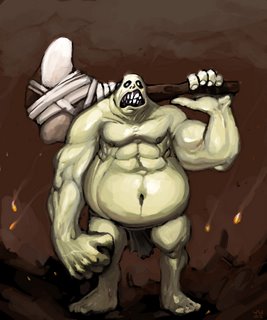 This may look like a mean, dumb ogre with bad teeth and a glandular problem, but he has a well-paying job with the Transportation Security Administration working the metal detector wand at Dallas-Ft. Worth Int'l Airport. This may look like a mean, dumb ogre with bad teeth and a glandular problem, but he has a well-paying job with the Transportation Security Administration working the metal detector wand at Dallas-Ft. Worth Int'l Airport.Now I'm all het up and cranky. I never should have mentioned the trip home. Deep breaths. OK, all better. All in all, it was a fabulous trip, and I highly recommend getting off the beaten path when traveling to Mexico, or indeed any other country for that matter. It's always more challenging and more rewarding to be the only tourists in town. For me visiting Mexico was especially interesting because I haven't been there in about 20 years, though I spent a couple of months living in Veracruz when I was 15 (my parents must have been completely insane). I had never been to the central highlands, but Mexico in general was much changed from my memories, and you can see the influence of an expanding economy and returning Mexican-Americans. On the plus side, the roads are much better, as are the cars. In 1983 when I was last in Mexico City easily two thirds of the cars were VW Beetles. They have graduated to compact Japanese cars now, with a smattering of vans and larger cars. SUV's, however, have not gained much of a foothold, no doubt due to the narrowness of the roads and the necessity of bold snake-like driving techniquest inthe city. Old buildings in the cities are being maintained and restored, but new ones are mainly of the speedy and cheap cinderblock/cement construction that blights the landscape across the developing world. On the minus side, certain North American urban marketing techniques are in evidence, including roving pampleteers passing out flyers about chemical peel opportunities and the unbelievable over-hype of Valentines Day. Signage, always omnipresent on Mexican walls, poles, billboards, etc, is still largely political -- an election was underway during our stay, though our driver insisted all the candidates were crooks (likely true), but I was intrigued by a few additions. Anti-smoking signs had been posted in various places, as were exhortations encouraging recycling. Hypertention clinics and Alcoholics Anonymous chapters in small rural towns seemed to imply both modernization and the stressful price of modernization. I guess that wraps it up! If you want more information about the cooking school, Puebla, or Tlaxcala, here are a few links: Tlaxcala tourism (great site, but unfortunately in Spanish, and we know that translation isn't the Tlaxcala government's strong suit) Mexican Home Cooking School (recommended!) Tlaxcala tourism info in English (pretty weak, actually, but there's not much out there in English) Puebla tourism in Spanish (Also not translated, unfortunately, since it's by far the best site for Puebla tourism) Puebla tourism in English (same lame site as for Tlaxcala) Hasta luego! Or more accurately, Hasta el proximo viaje! (5) comments Thursday, March 02, 2006
Day 9 - Extra Photos Since I haven't decided what to write to wrap up this little vacation, here are a few extra photo for your viewing pleasure today!  Mom is fortunate to have so much packing assistance. 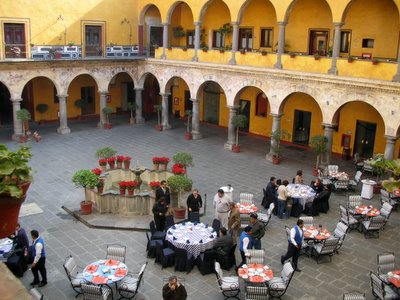 Sunday Brunch at the Camino Real in Puebla.  Mini tortilla factory in Cholula. It's hard to see, but there's a Help Wanted sign behind her -- another job opportunity for me!  View from town of the Cholula pyramid and church on top. 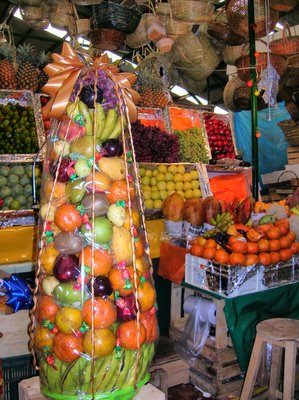 Now that's a fruit basket! 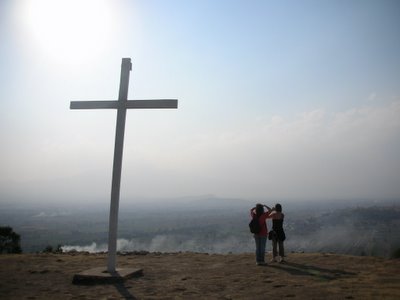 Top of the Spriral Pyramid at Xochitecatl. 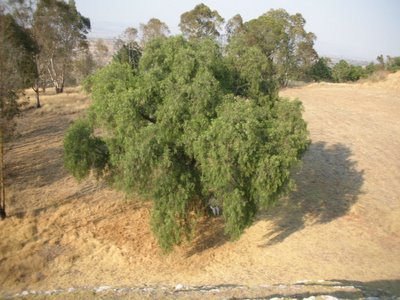 This one was taken from the top of the Spiral Pyramid. If you look very closely, you can see mom under that tree reading her book.  Why use a blanket when the dog chow bag is the perfect size? (c) 2006 Katy Warren (0) comments Wednesday, March 01, 2006
 Day 8 - Part 3 - Tlaxcala 2/18/06 Day 8 - Part 3 - Tlaxcala 2/18/06We took another shot at Tlaxcala city in the afternoon, hitting the overwhelming local Saturday market and doing some final shopping in the craft market just off the zocalo. The difference in atmosphere was interesting. The vast local market encompassed a huge high-ceilinged permanent structure and all of the surrounding streets for blocks around. According to Yair, very good prices are available for everything from luggage to lingere to refrigerator magnets to tripe, and in the early morning agricultural goods are sold wholesale. As a result, the presence of the big local market reportedly keeps prices down all over town. As A commented, it's the Wal-Mart of Tlaxcala. The vendors at the market really wanted to move product, too, with loud and persistent sales pitches for any and all products. Did they really think a gringa with a camera was going to want to purchase a two kilo bag of meat or a clothes hamper? Issues of reality and practicality did nothing to dissuade them from their sales efforts. They obviously had no desire to re-pack unsold merchandise for the trip back home. By contrast, the vendors of the craft market were so laid back I feared some might fall asleep during a transaction. And although we were ideal customers -- tourists on their last day in Mexico with pesos remaining and next Christmas to think about -- most seemed to have very little interest in our presence. The ones who did, however, had a very good day. Products purchased, errands run, a final Moka FriOreo Frappe (sob!) consumed, we headed back to the Zocalo only to witness a very strange performance by a group of drunken, dancing Sasquatches whipping the sidewalk in unison. Yeah, I don't know either. We returned to our sunny little oasis on the hill (see, I'm learning new writing techniques from "Tlaxcala Loves You") to watch the sun set over Mt. Ixtacihuatl and contemplate the depressing prospect of packing and returning to the frozen north. Some final pictures of Tlaxcala, many of them Mom's:  Tlaxcala's Palace of Justice. As you can see, the Mexicans are not afraid of using color on their buildings. Tlaxcala's Palace of Justice. As you can see, the Mexicans are not afraid of using color on their buildings.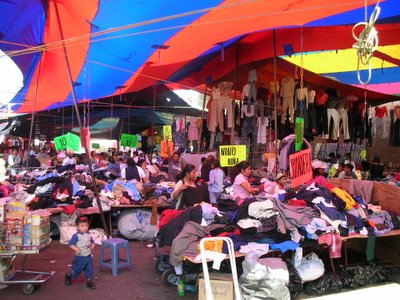 Need some clothes? Need some clothes? Fighting off the crowds at the craft market. Fighting off the crowds at the craft market. Check out those fruit baskets! I hate to think of what happens when you take the plastic off. Check out those fruit baskets! I hate to think of what happens when you take the plastic off.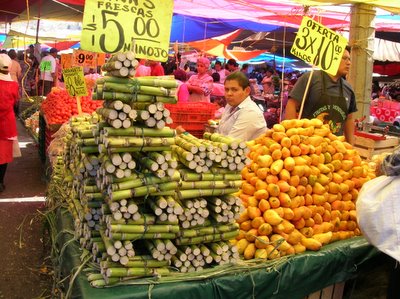 I'm not quite sure what these sticks are for, but they must be food, right? I'm not quite sure what these sticks are for, but they must be food, right?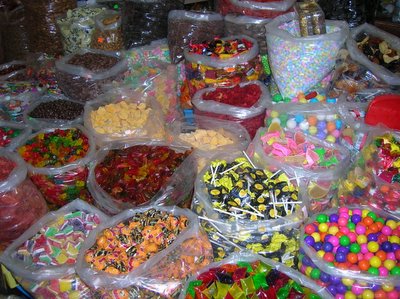 Teeth-rotting goodness. Teeth-rotting goodness.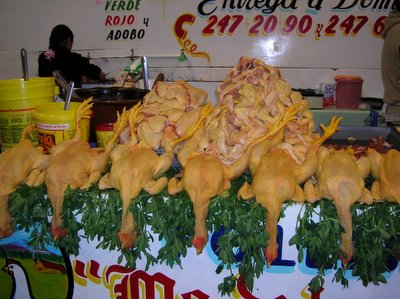 I must say I prefer getting my chicken pre-boned on little styrofoam trays. I must say I prefer getting my chicken pre-boned on little styrofoam trays. And that goes double for pork. And that goes double for pork.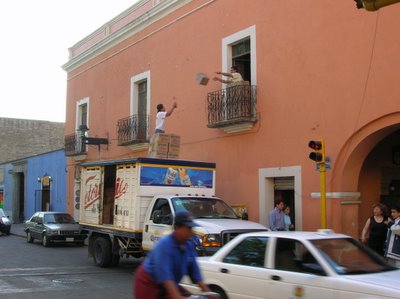 Need to get your beer to the second floor? Why use stairs when you can toss it straight up? Need to get your beer to the second floor? Why use stairs when you can toss it straight up?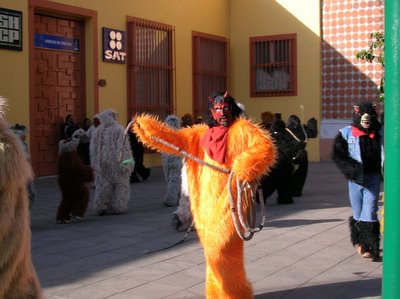 I don't get it either. I don't get it either. |